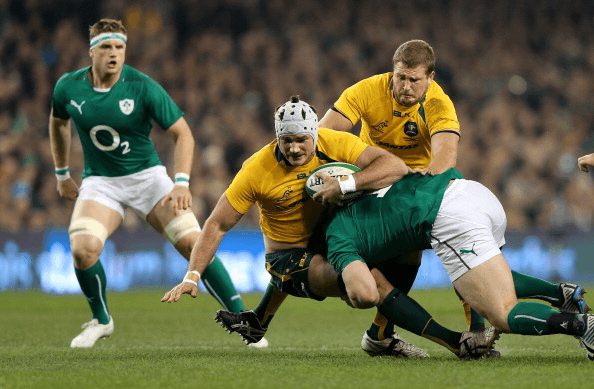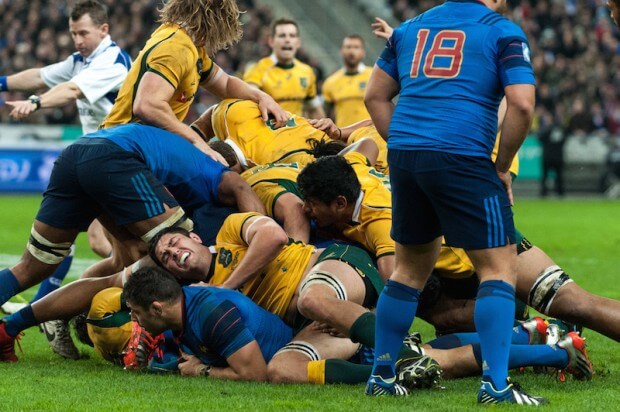Scheduled Website Maintenance
We’re currently in the process of moving to a new and improved server environment. During this transition, the website may experience brief interruptions or temporary outages.
We appreciate your patience while we complete this upgrade. Service will return to normal shortly, with improved performance and reliability.
Thank you for your understanding.
4. Wallaby Attacking and Defensive Structures
Attack – No specific coach (Jim McKay left with Ewen McKenzie)
The Wallabies want to employ the same high speed game that the Waratahs use, with forwards in the midfield to draw in defenders before attacking wide and beating the fold. Bernard Foley stands deep at the Wallabies, and doesn’t seem willing to take the ball to the line before distributing. This could be partly due to the quality of service he’s receiving. With the backline so deep, whenever the Wallabies are faced with aggressive linespeed and a defence that is able to communicate effectively they rely on dominant carries to reach the advantage line. Ballrunners with leg drive like Tevita Kuridrani become standout players for their ability to perform well under this kind of pressure. However, if that leg drive isn’t there and runners are being tackled behind the line after getting isolated from their supporters, the ball is available to be counter-rucked. If the Irish take a leaf out of the French book and spread their defensive line, you can be assured that the Wallaby forwards will create turnovers themselves by neglecting to protect their ball effectively.
Watch out for the Irish linespeed in defence on Sunday morning. What will make this a thrilling contest is that everyone, including the Wallabies, know it’s coming. Whether the Wallabies try to beat this by putting in short kicks behind the line as they did against England last year, or utilise the pick and drive to negate the speed off the line is anybody’s guess.
Given the likelihood that conditions will be poor I’d wager that the Wallabies will keep it tighter.
Defence – Nathan Grey
The Wallabies are vulnerable in defence during this transition period from Nick Scrivener’s defensive system to Nathan Grey’s, used so successfully at the Waratahs. All defences in rugby are only as strong as their weakest link, and one clear weak link from the Wallabies recent matches is their ruck defence. Irish scrumhalf Connor Murray is arguably the second best halfback in the world right now behind Aaron Smith, and he’s more than athletic enough to punish defenders who forget to defend the A channel. Sean McMahon was guilty of this twice in two tests, and it resulted in two tries. In my book that constitutes a weakness – where is the defensive sweeping halfback in these situations?
Another early hallmark of Nathan Grey’s system is the use of the two centers as defensive captains, leading the Wallaby linespeed and frequently shooting out of it with the intent to kill overlaps before they can develop. Often this can work very effectively, but when teams are prepared for it the tactic will invariably leave the wingers stranded on an island with more attackers than they could hope to defend. Funnily enough it would seem that the Wallabies best efforts to stop teams exploiting them in the wide channels is causing greater damage, and drawing attention to the fact that they are vulnerable out wide. What causes the overlaps out wide are generally when the Wallaby back 3 drop back to cover kicks, whilst the halfback sweeps behind the line. With those minimum four defenders out of the line (occasionally Bernard Foley will drop back to support also) and more tied up in the ruck, the Wallabies are generally left defending the entire with of the pitch with two thirds the manpower that the attack does. Hence, the two or three man overlaps you would have seen against France and Wales.
This catch-22 places the greatest strain of all on the Wallaby defence. Pay attention to the work of Toomua and Kuridrani clamping down on their opposite numbers on Sunday morning. If the Irish are skillful enough to get the ball out to their dangerous wings in Simon Zebo and Tommy Bowe by passing or by kicking then the Wallabies could well lose the test.


